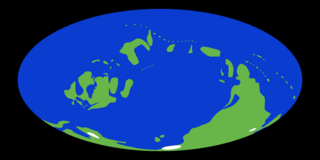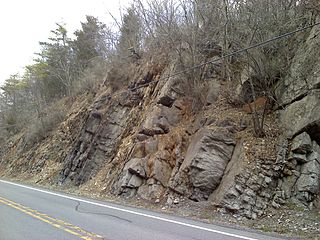
The Devonian is a geologic period and system of the Paleozoic era during the Phanerozoic eon, spanning 60.3 million years from the end of the preceding Silurian period at 419.2 million years ago (Ma), to the beginning of the succeeding Carboniferous period at 358.9 Ma. It is named after Devon, South West England, where rocks from this period were first studied.

The Silurian is a geologic period and system spanning 24.6 million years from the end of the Ordovician Period, at 443.8 million years ago (Mya), to the beginning of the Devonian Period, 419.2 Mya. The Silurian is the shortest period of the Paleozoic Era. As with other geologic periods, the rock beds that define the period's start and end are well identified, but the exact dates are uncertain by a few million years. The base of the Silurian is set at a series of major Ordovician–Silurian extinction events when up to 60% of marine genera were wiped out.

Conodonts are an extinct group of jawless vertebrates, classified in the class Conodonta. They are primarily known from their hard, mineralised tooth-like structures called "conodont elements" that in life were present in the oral cavity and used to process food. Rare soft tissue remains suggest that they had elongate eel-like bodies with large eyes. Conodonts were a long-lasting group with over 300 million years of existence from the Cambrian to the beginning of the Jurassic. Conodont elements are highly distinctive to particular species and are widely used in biostratigraphy as indicative of particular periods of geological time.

Thelodonti is a class of extinct Palaeozoic jawless fishes with distinctive scales instead of large plates of armor.

Heinz Christian Pander, also Christian Heinrich Pander was a Russian biologist and embryologist of Baltic German origin.

In the geological timescale, the Llandovery Epoch occurred at the beginning of the Silurian Period. The Llandoverian Epoch follows the massive Ordovician-Silurian extinction events, which led to a large decrease in biodiversity and an opening up of ecosystems.

In the geologic timescale, the Přídolí Epoch is the uppermost subdivision of the Silurian Period, dated at between 423 ± 2.3 and 419.2 ± 3.2 mya. The Přídolí Epoch succeeds the Ludfordian Stage and precedes the Lochkovian, the lowest of three stages within the Lower Devonian geological epoch. It is named after one locality at the Homolka a Přídolí nature reserve near the Prague suburb, Slivenec, in the Czech Republic. The GSSP is located within the Požáry Formation, overlying the Kopanina Formation. Přídolí is the old name of a cadastral field area.

The Late Silurian to Early Devonian Keyser Formation is a mapped limestone bedrock unit in Pennsylvania, Maryland, Virginia, and West Virginia.

Paleontology in Wisconsin refers to paleontological research occurring within or conducted by people from the U.S. state of Wisconsin. The state has fossils from the Precambrian, much of the Paleozoic, some a parts of the Mesozoic and the later part of the Cenozoic. Most of the Paleozoic rocks are marine in origin. Because of the thick blanket of Pleistocene glacial sediment that covers the rock strata in most of the state, Wisconsin’s fossil record is relatively sparse. In spite of this, certain Wisconsin paleontological occurrences provide exceptional insights concerning the history and diversity of life on Earth.

The evolution of fish began about 530 million years ago during the Cambrian explosion. It was during this time that the early chordates developed the skull and the vertebral column, leading to the first craniates and vertebrates. The first fish lineages belong to the Agnatha, or jawless fish. Early examples include Haikouichthys. During the late Cambrian, eel-like jawless fish called the conodonts, and small mostly armoured fish known as ostracoderms, first appeared. Most jawless fish are now extinct; but the extant lampreys may approximate ancient pre-jawed fish. Lampreys belong to the Cyclostomata, which includes the extant hagfish, and this group may have split early on from other agnathans.
Wurmiella is an extinct conodont genus.
Ozarkodina is an extinct genus of conodonts in the family Spathognathodontidae.
George Jennings Hinde was a British geologist and paleontologist.

Polygnathus is an extinct genus of conodonts.
Zieglerodina is an extinct conodont genus in the family Spathognathodontidae.
Lanea is an extinct conodont genus in the family Spathognathodontidae from the Early Devonian.
Pseudopolygnathus is an extinct genus of conodonts in the family Polygnathidae.
Cryptotaxis is an extinct genus of conodonts in the family Cryptotaxidae from the Famennian.
Oulodus is a genus of conodonts in the family Prioniodinidae.

Panderodus Is an extinct genus of jawless fish belonging to the order Conodonta. This genus had a long temporal range, surviving from the middle Ordovician to late Devonian. In 2021, extremely rare body fossils of Panderodus from the Waukesha Biota were described, and it revealed that Panderodus had a more thick body compared to the more slender bodies of more advanced conodonts. It also revealed that this conodont was a macrophagous predator, meaning it went after large prey.











